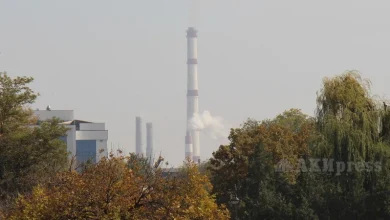Inside Putin’s campaign of terror in Kyiv: Why Russia keeps bombarding the capital

On The Ground newsletter: Get a weekly dispatch from our international correspondents
Get a weekly dispatch from our international correspondents
Get a weekly international news dispatch
Russia launched a blistering assault on Ukraine overnight, killing at least six people and injuring 35. Some 430 drones and 18 missiles targeted the country, Ukraine’s president said, calling the strikes a deliberate and calculated attack “aimed at causing maximum harm to people and civilian infrastructure”.
Ukraine’s air force said most of the drones and missiles were shot down, but officials said falling debris and fires damaged high-rise apartments, a school, a medical facility and administrative buildings across nine districts in the city of about three million.
“At that moment you don’t know what to do first: save yourself, your child, or run to help people, because so many people were screaming and needed help,” said Anastasia, 29, whose apartment block was hit.
The attacks came just two days after Russia’s foreign ministry indicated it was ready to resume direct talks with Ukraine on ending the war in Istanbul. An official told TASS the “ball is in Ukraine’s court”.
Russia continues to escalate its strikes on Ukraine while coordinating its messaging to present a show of good faith to the United States. Nearly four years since the invasion, the Kremlin maintains its maximalist designs on Ukraine.
Zelensky said that Ukraine was responding to the strikes with “long-range strength”, and called for greater sanctions to be imposed on Russia.
open image in gallery
The overnight attacks hit residential buildings, despite Russia’s insistence it does not target civilians (AFP/Getty)
Russia has waged a devastating aerial campaign against Ukraine since its all-out invasion of its neighbour nearly four years ago. US-led diplomatic efforts this year to stop the fighting have so far come to nothing.
Friday’s aerial assault, which also targeted Odesa in the south and Kharkiv in the northeast, was mostly aimed at Kyiv, where drones and missiles smashed into high-rise apartment blocks, according to Zelensky.
Mariia Kalchenko said it was a miracle she survived after her building was hit. “I didn’t hear anything, I just realised that my hair was on fire,” the 46-year-old volunteer rescue dog handler said.
In the Odesa region, Russian drones struck a busy street on market day in Chornomorsk, killing two people and injuring 11 others, including a 19-month-old girl, regional military administration chief Oleh Kiper said.
Moscow denies targeting civilian areas, with the Russian Defense Ministry saying Friday it carried out an overnight strike on Ukraine’s “military-industrial and energy facilities.”
Analysts nevertheless accuse Russia of deliberately targeting civilian infrastructure in order to wound morale.
open image in gallery
Eight of the capital’s 10 districts reported damage. Emergency crews fought fires in apartment blocks, debris from explosions was strewn across yards and cars parked in the streets were set ablaze (Reuters)
Natia Seskuria, an associate fellow at the Royal United Services Institute (RUSI), said that the “systematic” targeting of civilian infrastructure was a “central element” of Russia’s strategy, “designed to terrorise the Ukrainian population and erode public morale”.
“The underlying calculation is that a war-weary society subjected to sustained attacks might exert pressure on the government to accept almost any settlement that promises an end to hostilities,” she told The Independent.
“Thus far, however, this strategy has proven ineffective, as Ukrainians have demonstrated remarkable resilience and determination in the face of ongoing aggression.”
Friday’s attack was the biggest on Kyiv in almost three weeks. Most recent Russian aerial attacks have aimed at electricity infrastructure around the country ahead of the bitter winter months.
With no sign of the war abating, millions of Ukrainians face one of the harshest winters in years as humanitarian organisations scramble to deliver essentials to the frontlines and affected areas.
The International Federation of Red Cross and Red Crescent Societies (IFRC) warned on Friday that people whose livelihoods have been destroyed by the war are entering the winter with “no financial buffer” to support themselves.
open image in gallery
At least six people were killed in the strikes overnight, Ukrainian officials said (Reuters)
Frequent power cuts continue to plunge neighbourhoods into darkness, cut heating and force hospitals to use emergency power. For older people and vulnerable people in high-rise buildings, blackouts can mean hours or days of isolation without elevators, heat, and often without food or medicine, the IFRC warned.
“Almost four years of conflict have eroded people’s resources. Many families are entering this winter with no financial buffer – seven out of ten people said they don’t have any savings left,” said Jaime Wah, Deputy Head of Delegation for IFRC in Ukraine.
“We have been providing support to people for several years, but our resources are also running thin,” Wah added. “The scale of the needs is overwhelming, and with each passing day, those needs only grow.”
Keir Giles, a fellow of the Russia and Eurasia programme at Chatham House, told The Independent that Moscow’s attacks are designed to “cause the maximum possible misery and suffering among the civilian population”.
“That’s the principle we saw applied in Syria, in Chechnya and in countless others of Moscow’s wars dating back decades and centuries,” he said.
Mr Giles said Ukraine was “the victim of Russia’s attempts to demoralise its victims through inhumanity.
“That’s the reason for attacks on maternity hospitals, and nurseries, targeting the most vulnerable in society, as well as for the systematic torture and starvation of Ukrainian military and civilian captives – not for any objective purpose other than deliberate and demonstrative cruelty.”
These attacks continue despite Russia’s insistence that it is open to talks moving towards a ceasefire.
open image in gallery
(Reuters)
Foreign ministry official Alexei Polishchuk said on Wednesday that Russia was ready to resume negotiations with Ukraine in Istanbul. No face-to-face talks have taken place between the two sides since they met in the Turkish city on July 23.
Overtures towards peace come after a proposed summit between Russia’s Vladimir Putin and US president Donald Trump broke down in October, reportedly over Moscow’s intransigence over its demands.
The two leaders have not met since August, when a summit held in Alaska failed to produce a deal. Mr Trump said the meeting was “very productive”, but the diplomatic push to end the war has yet to yield any results.





